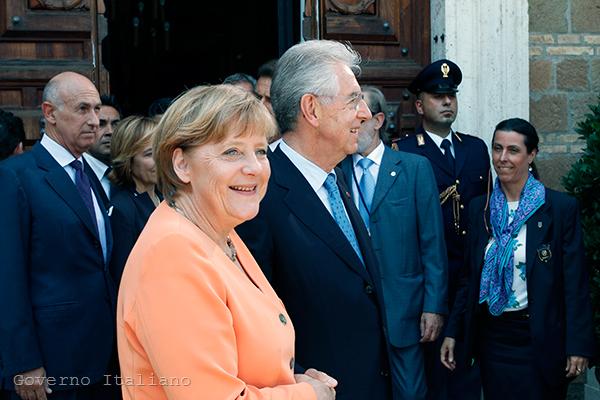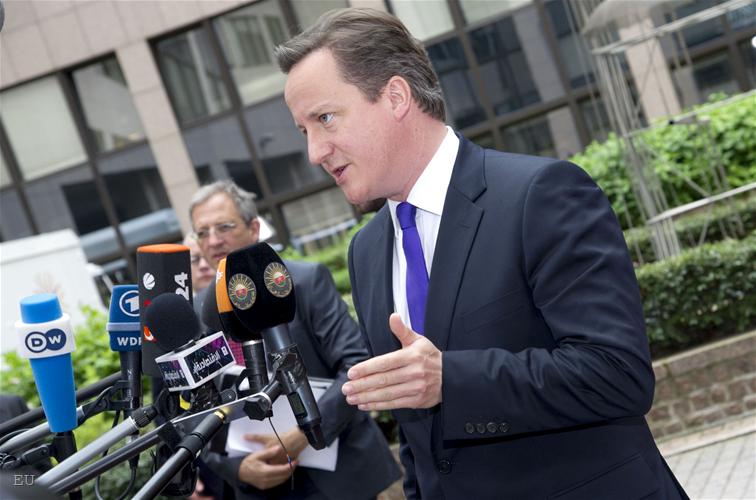Growth for All and All for Growth
Adelina Marini, July 3, 2012
 Now it is certain that the talk about growth in the EU has no other purpose but to generate domestic political dividends. And this would not have been bad if too much attention was not paid to it as a single element of a more general picture - who is dragging the cart and why are not all dragging it? In fact, the latest crucial EU summit in Brussels on June 28-29 had no other purpose but to convey a message that Europe could manage, at least if we judge by the speech of Jose Manuel Barroso, European Commission president, on the eve of the European Council, in which he said that the world expected from Europe "to commit to credible and concrete solutions to become more integrated and more united". And indeed there is a message but it is another question whether it fulfils the main requirement - Europe to be able to handle it with credible and concrete decisions.
Now it is certain that the talk about growth in the EU has no other purpose but to generate domestic political dividends. And this would not have been bad if too much attention was not paid to it as a single element of a more general picture - who is dragging the cart and why are not all dragging it? In fact, the latest crucial EU summit in Brussels on June 28-29 had no other purpose but to convey a message that Europe could manage, at least if we judge by the speech of Jose Manuel Barroso, European Commission president, on the eve of the European Council, in which he said that the world expected from Europe "to commit to credible and concrete solutions to become more integrated and more united". And indeed there is a message but it is another question whether it fulfils the main requirement - Europe to be able to handle it with credible and concrete decisions.
And the question is very reasonable, given that since the very beginning of the year Europe has been talking constantly about growth. Moreover, it uses very populist rhetoric. Yet the first meeting of the EU leaders in the beginning of the year was dedicated precisely on growth, then it was the Spring European Council which ended with an ambition to boost the European economic growth, until it came to the informal dinner in honour of the new French president, Francois Hollande. Then, if you remember, he clearly demonstrated that he would not be in harmony with Angela Merkel, the German chancellor, and would pursue his own agenda. This agenda, however, endured certain changes. Initially, in his pre-election activities, Mr Hollande wanted the fiscal compact reopened, which is now in the process of ratification by the 25 EU member states after Britain and the Czech Republic refused to sign it, to include a commitment to growth.
remember, he clearly demonstrated that he would not be in harmony with Angela Merkel, the German chancellor, and would pursue his own agenda. This agenda, however, endured certain changes. Initially, in his pre-election activities, Mr Hollande wanted the fiscal compact reopened, which is now in the process of ratification by the 25 EU member states after Britain and the Czech Republic refused to sign it, to include a commitment to growth.
 Later, at his first meeting with the German chancellor in Berlin, Hollande softened and announced that legal possibilities would be sought to satisfy his desire, behind which one way or another stood the prime ministers of Italy and Spain - Mario Monti and Mariano Rajoy. Ultimately, what the leaders produced as an outcome from their June summit was a Pact for Growth and Jobs. The idea behind such a formulation and preparation of the document was to play the role of something like a left shoulder of the fiscal compact, but definitely the two are not put on an equal footing legally. In order for them to have equal power, the two documents had to be legally binding. The proposed by the leaders text does not leave such impressions.
Later, at his first meeting with the German chancellor in Berlin, Hollande softened and announced that legal possibilities would be sought to satisfy his desire, behind which one way or another stood the prime ministers of Italy and Spain - Mario Monti and Mariano Rajoy. Ultimately, what the leaders produced as an outcome from their June summit was a Pact for Growth and Jobs. The idea behind such a formulation and preparation of the document was to play the role of something like a left shoulder of the fiscal compact, but definitely the two are not put on an equal footing legally. In order for them to have equal power, the two documents had to be legally binding. The proposed by the leaders text does not leave such impressions.
The economic growth: usage manual
The growth pact repeats everything the EU has been talking about since the beginning of the year intensively and not that intensively for several years - member states to abide to the commitments they took with the Europe 2020 strategy, which in fact is the main 10-year commitment of the EU to growth; to stick to the new rules for economic governance of the EU (the six pack and the currently being hammered out second package of the economic governance, known as the two-pack); to implement the recommendations of the Commission as part of the European Semester; to maintain strict fiscal discipline, but without killing their opportunities for growth; to try and restore the normal process of lending for businesses to fight unemployment and to help  the socially vulnerable; and last but not least, to reform their public administrations, mostly by removing delays in the judiciary, the administrative burdens and develop e-services. All of these things, spoken of a number of times, not only the first semester of this year.
the socially vulnerable; and last but not least, to reform their public administrations, mostly by removing delays in the judiciary, the administrative burdens and develop e-services. All of these things, spoken of a number of times, not only the first semester of this year.
In the pact measures are agreed on European level, which also do not sound unfamiliar - improving the single market governance, as well as its deepening, where there are some important elements, which will be mentioned below; increasing the capital of the European Investment Bank by 10 bn euros; a pilot launch of project bonds to fund projects in transport, energy and broadband infrastructure, amounting to 4.5 bn euros.
A victory for the patent
May be the only and biggest achievement, which is part of the growth pact, is the agreement on unitary patent that put an end to almost three decades of disputes in the European Union. The agreement was possible after a compromise was struck the seat of the European Patent Court to be divided into three. And here there is a big victory for France, because the central division of the court will be in Paris and the first president of the court will be a Frenchman. Because of the highly specialised nature of patent litigation, it has been decided two thematic clusters of the court to be created - one in London, to deal with chemistry, including pharmaceuticals, and the other in Munich to deal with mechanical engineering. It is not provided for a defendant to request a transfer of litigation from the local division to the central if the defendant is domiciled within the EU.
With this decision was put an end of disputes, which took a lot of time at the EU summit too, when it became clear that David Cameron, the British prime minister, threatened to block the process if an agreement was not reached.
Certain progress for the Services Directive
 The second important element of the deepening of the single market is the leaders' call the Services Directive to be implemented immediately. Recently the Commission presented a study of the implementation of the directive, which showed terrible results - in spite of the entering into force of the legislation in end-2009, a few countries implement it entirely, which is why it is difficult to empirically study what its impact on growth is. In their conclusions the leaders state that if this directive is implemented, it could bring additional 330 bn euros of economic benefits.
The second important element of the deepening of the single market is the leaders' call the Services Directive to be implemented immediately. Recently the Commission presented a study of the implementation of the directive, which showed terrible results - in spite of the entering into force of the legislation in end-2009, a few countries implement it entirely, which is why it is difficult to empirically study what its impact on growth is. In their conclusions the leaders state that if this directive is implemented, it could bring additional 330 bn euros of economic benefits.
The good news is that these nice but in a way empty words bear hope that this directive will not again be tucked away in some drawer of the national governments for the benefit of national protectionism. The key words in the conclusions are that the member states commit to make peer reviews on national restrictions and to undertake urgent measures to remove the "unjustified" barriers, while the Council will make a review of progress by the end of the year.
A pact for 120 bn euros
And in order not to sound in vain, the pact offers some concrete numbers, which the leaders to bring home. The equivalent of 1% of EU gross national income or around 120 bn euros will be mobilised to finance measures that would bring fast growth. These measures are precisely increasing the capital of the EIB with 10 bn euros; the project bonds, which envisage investments worth 4.5 bn euros; 55 bn euros in support of small and medium sized enterprises, which will be paid through the EU structural funds. Separately, the leaders have agreed to use the next budget framework for the period 2014-2020 for the benefit of growth and jobs creation.
and medium sized enterprises, which will be paid through the EU structural funds. Separately, the leaders have agreed to use the next budget framework for the period 2014-2020 for the benefit of growth and jobs creation.
In fact, the growth pact was supposed to be reconciliation between austerity policies and policies to boost growth which, however, is initially a wrong approach, because the former should not be an impediment for the latter if it is done for the sake of boosting growth. It is a fact that a large part of the efforts for spending cuts are done in order to reduce debt but nowhere and no one ever said that they must be to the detriment of economic growth. Still unrefuted remain the theses that there is economic growth where there is effective public administration, judiciary and liberalised labour market; where there are viable small and medium-sized enterprises and the interference of the state is as a regulator not as an obstacle.
 And as it was very much talked about that Francois Hollande, together with Monti and Rajoy, are the big winners of this summit, reading the growth pact shows clearly that the big winner from this summit is the European Commission, which for years has been making proposals on all these points, has been urging for their implementation, begged and pleaded, while being ignored on national level. The other big winner from this summit are the countries who combine in a smart way austerity measures with growth; which invest in education and technological infrastructure and those who look externally not only internally.
And as it was very much talked about that Francois Hollande, together with Monti and Rajoy, are the big winners of this summit, reading the growth pact shows clearly that the big winner from this summit is the European Commission, which for years has been making proposals on all these points, has been urging for their implementation, begged and pleaded, while being ignored on national level. The other big winner from this summit are the countries who combine in a smart way austerity measures with growth; which invest in education and technological infrastructure and those who look externally not only internally.
These countries have won because in the growth pact it is explicitly written that financial stability is a prerequisite for growth. In other words - not the growth pact entered the fiscal compact but the other way round. And this is so because the growth pact is nothing more than a call that the rescue of the drowning men is in their own hands - something that hardly needed a night without sleep to be stated again.
 | © Governo Italiano
| © Governo Italiano | © EU
| © EU | © null
| © null